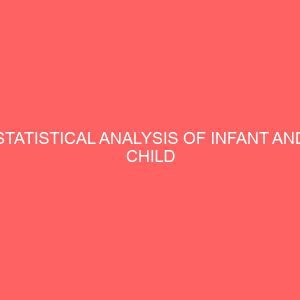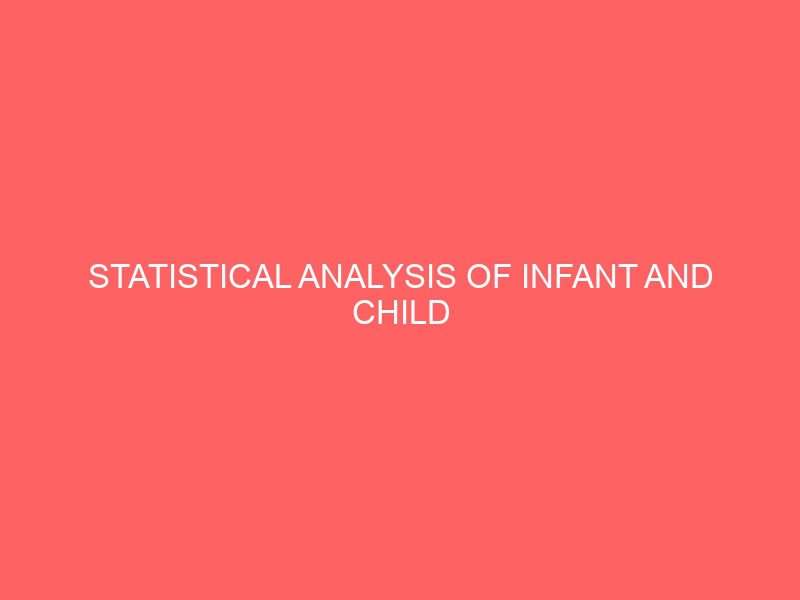Description
STATISTICAL ANALYSIS OF INFANT AND CHILD MORTALITY RATE
ABSTRACT
The research work “analysis on infant and child mortality in federal medical centre (f.m.c) Keffi” was carried out to: test for the difference of two means between infant and child mortality rate; estimate infant and child mortality rate; estimate age specific fertility rate; and to determine the trend line and forecast of infant and child mortality. The data for the research was collected using a documentary method, and was analyzed using; time series analysis, difference of two means (Two sample T-test), and measures of mortality and fertility. At the end of the research it was found that the incidence of child and infant mortality has been on the decrease from 2001 to 2015. It was also found that there is no significant difference in the occurrence of both infant and child mortality. At the end of the research the researcher recommended that government should organize a yearly interval workshop in other to enlighten people on infant and child health care, all individual should avoid personal medication; all cases of illness should be reported to a medical expert, especial when it comes to children as their immune system is more volatile, The government should also create awareness campaign to educate the public on how to report all causes of death, and All pregnant women should be encouraged to enroll in ante-natal care.
CHAPTER ONE
INTRODUCTION
1.1 BACKGROUND OF THE STUDY
Infant mortality refers to the death of a child born alive before its first birthday and child mortality is the death of a child aged between one and five years. Demographers have for a long time been interested in the study of mortality which is one of the components of population change. Infant and child mortality are among the best indicators of socioeconomic development because a society life expectancy at birth is determined by the survival chance of infants and children.
Childhood mortality is an important indicator of all heath programs and policies; likewise it contributes to population projection. Childhood mortality measures also help identify specific population that are at increase in health risk. Several measures of childhood mortality are calculated using Demographic Health Survey (DHS) data. During the twentieth century almost all countries experienced decreases in child mortality rate. However, the timing and pace of the decline varied substantially. Sustained reductions in child mortality began in the nineteenth century in Europe, North America, and Japan and continued gradually throughout the twentieth century. Major declines in other parts of the world generally began only after World War II. Mortality reductions in Asia, Latin America and Africa were usually much more rapid that they had been in countries that began mortality declines earlier. By 1999 there were great variations in child mortality among countries for example, although less than 0.5 percent of children died before the fifth birthday in Iceland, more than 33 percent died by age five in Niger. Since the 1960s the decline in child mortality sometimes has appeared to have stagnated as was the period from 1975– 1985, when many poor countries experienced severe crises and other problems such as economic recovery from the 0.1 crisis of 1973 – 1974. Recent evidence suggests that child mortality has continued to decline in most countries since 1980. However, during the 1990s the HIV/AIDS epidemic halted or reversed declines in child mortality in some eastern and southern African countries. For example, in Zimbabwe in the period 1990 – 1994 there were 50 deaths under age five per 1,000 live births.
Statistics therefore as the science of information analysis or scientific method of collecting, presenting or organizing and interpreting numerical data in such a way that valid and useful conclusion will be drawn to clear away uncertainties. It implies in many aspects of studies and life in general one of the aspects is demography. The demography means the study of human population and factors that affect it. These are fertility, morbidity mortality etc. but the scope of these project be centered on analyzing infant and child mortality rate among various age groups we shall consider how genders is also related to death in a particular age group.
Federal Medical Center Keffi (FMC) was formally known as General Hospital Keffi. It is located at the center of the town, along old Akwanga road; it was upgraded to its current status as Federal Medical Center (FMC),during the first democratic government of former Senator, Dr. (Alh) Abdullahi Adamu, the Sarkin Yakin Keffi, and the Aare Obateru of the source in the year 2003. The hospital then had a staff capacity of 1687with a bed space of 774.Currently the Federal Medical Center (FMC) Keffi has over 3687 work force (staff) with about 1200 bed space in estimate. FMC was built in order to create easy access to good medical facility to its populace (Nasarawa State) people of Nigeria at large.
1.2 STATEMENT OF PROBLEM
The incidence of infant and child mortality has been of great concern to both the government and individuals. The needs for policies that may adequately arrest the situation cannot be achieved without some in depth acquaintance with the available dates. This study will address vital issues as the fate of infant mortality, child mortality, and age specific fertility. It will in addition consider the trend of infant and child mortality and the difference between them specifically at the Federal Medical Centre Keffi.
1.3 AIM AND OBJECTIVES OF THE STUDY
1.3.1 AIM
To analyze the reported cases on the incidence of infant and child mortality in FMC Keffi.
1.3.2 OBJECTIVES
- To test for the difference of two means between infant and child mortality rate.
- To estimate infant and child mortality rate.
- To estimate age specific fertility rate.
- To determine the trend line and forecast of infant and child mortality.
1.4 SIGNIFICANCE OF THE STUDY
It is expected that findings from the study will greatly assist Nasarawa State in determining the extent to which several measures that are put into place have been effective in reducing mortality rate in Nasarawa States.
The finding will also assist the government to come up with definite policies on how to minimize infant and child mortality rate.
1.5 DELIMITATION OF THE STUDY
In this study, the number of the mortality considered are two which are the infant and child mortality in Federal Medical Centre Keffi, Nasarawa State.
1.6 LIMITATION OF THE STUDY
In the process of carrying out the research work time constraint and financial problem are the problems faced during the course of obtaining data from the medical center.
1.7 HYPOTHESES OF RESEARCH QUESTION
There is no significant difference between infant and child mortality rate in FMC Keffi
There is significant difference between infant and child mortality rate in FMC Keffi
1.8 DEFINITION OF TERMS
Neonatal Mortality: The probability of dying within the 1st month of life.
Infant Mortality: The probability of dying before the 1st birthday
Child Mortality: The probability of dying before the fifth birthday.
Crude Death Rate: This is the simplest and commonest mortality measurement it defines as the number of death in a year per one thousand of the mid population i.e.
CDR = D/P x k
Where;
D =number of death in a given year
P =total population of the mid-year
K = constant
Age Specific Death Rate: This is the number of death of person ofa given age during a year per one thousand (1000) populations. It isusually compared 5 — 10 years age range. Though consideration isusually given to the infant because of their relatively great multitude of death rates, hence separate rate are usually shown for the group.
Between 1 – 4 years.
ASDR=
Where;
is the number of deaths in a given year say 0 — 4 month
is the total population of age 0 — 4 month of mid-year K is the constant.
Cause Specific Death Rate: This is the number of death from a given cause or group of causes during a year per ten thousand of mid-year population in cause specific death rate larger constant is used because there are relatively few deaths from many of the cause.








Reviews
There are no reviews yet.